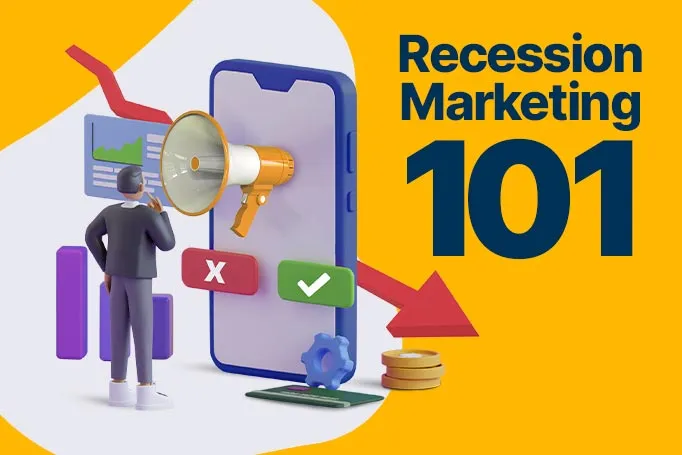After the pandemic and in the midst of a recession, retail marketers are stuck between a very large rock and a very small hard place. There’s no denying that we are in the midst of a recession, and your consumers are feeling the economic downturn as much as you are.
Consumers aren’t willing to shell out that extra cash on a nice pair of jeans; they’re saving for a rainy day. Especially when the cost of those jeans could get them a full tank of gas.
Much like your advertising spend, consumer spending is expected to drop. People are going through hard times and the last thing that they want are constant reminders of the things that they can no longer afford.
For marketers, this poses a particularly difficult challenge. Our jobs are to increase brand awareness, but there’s no point in that if it’s going to hurt your customer experience or put a bad taste in consumers’ mouths.
Coupled with this is the question of whether or not to cut down on ad spend, considering that the business’s bottom line is being negatively affected by the recession. Marketing investments may not be top priority in the short term.
It’s time to address the elephant in the room: Should you advertise during a recession?
A brief history lesson.
Despite the initial reaction to do the opposite, history dictates that brands should absolutely continue advertising during a recession. While it may be tempting to slash that advertising budget and limit your marketing spend, this might convince you otherwise.
What do Kelloggs, Amazon, and Taco Bell all have in common?
The Great Depression: Before the Great Depression, Kelloggs was far from being the leading dry cereal brand. When the Great Depression hit, they amplified their advertising strategies when Post, the leading cereal brand at the time, cut advertising spending.
In the end, Kelloggs surpassed Post as the market leader and its profits grew by 30%.
1990-91 Recession: Before 1990, Taco Bell was a relatively small player in the fast food industry. With competitors such as McDonalds and Burger King, it seemed like they would never get ahead or overtake them.
When the recession hit, McDonalds slashed their advertising spend. Instead of following their lead, Taco Bell increased their advertising and introduced their value initiative. When all was said and done, Taco Bell increased their sales by 40% where McDonalds experienced a 28% decline.
The Great Recession: Instead of walking in the footsteps of large book retailers like Borders and Barnes and Noble, Amazon took the recession by the horns and amplified their advertising strategy.
Their market share increased by 28% in the midst of the Great Recession, mostly due to them providing a cost-effective alternative (ebooks) to physical books.
Instead of focusing on the short term impacts of the recession, these brands thought of the long term advantages of filling the gaps where their competitors were falling short.
Reassess your customer base.

During a recession, reassessing your demographics is mission-critical. For example, before the recession, marketing segmentation and targeting strategies were dominated by traditional demographics.
Instead of going by ‘middle-class, 40s, married mother of three’, separate your customers into four groups: The hard stop; The yellow light; Comfortable and steady; and YOLO.
The hard stop: These consumers are typically the ones who feel the impacts of the recession much harder and faster than the other three categories. They are typically single parents or consumers who are in a lower economic bracket. They will only shop for necessities.
The yellow light: These consumers are better off than the hard stop bracket, but are still weary enough to put a general stop to spending that isn’t for strict necessities. Although they limit their spending, they aren’t averse to a treat every once in a while.
Comfortable and steady: These consumers are typically the higher economic bracket and are financially comfortable enough to barely notice the impacts of the recession at all.
They go about life business as usual and while they are aware of higher gas and food prices, they aren’t likely to make sacrifices to make up for the costs.
YOLO: This is the group that justifies splurge purchases even if they can’t afford them (cell phones, cars, computers, designer clothes, etc.).
This is the ‘you only live once’ category. Our impulse buyers, and buyer’s remorse spenders. More likely to be younger generations and financially unhealthy consumers who buy most things on credit without a thought for the future impact of their purchases.
For recession marketing, bucketing your target audience into these four categories helps you further understand what is important to these consumers thereby giving you their pain points on a silver platter.
To learn more about the four categories, check out this Harvard Business Review article from the Great Recession where the four categories are explained in more detail.
Your recession marketing strategy
Your marketing budget may be in line for a reassessment, but before you start slashing this project or that campaign, conduct a competitive analysis and determine where your competitors are slacking (this will typically be in advertising).
A recession is a great time for brands to increase their share of voice (SOV) especially because their competitors are slowing down advertising efforts. Like Taco Bell and Kelloggs, a recession can give small and midsize businesses the space they need to take up more digital marketing real estate.
Social media is an especially good and cost-effective way to do this. Your target audience, no matter their demographics, live on social media. They’ll be easy to target and easy to engage, as long as you get your messaging and tone right.
A note on tone.

No matter how great your targeting strategies are, or how good the SOV opportunities are, the tone of your messaging matters…a lot.
Now that so many people (the majority) are being negatively affected by the recession, you can’t run a tone deaf campaign that touts the luxurious Chinese silks and French cashmere of your new sweater collection. Especially if your target audience falls in the yellow light category.
Instead of advertising luxury, adjust your messaging to reflect that a percentage of the proceeds from this campaign will go to Feeding America.
Another great advertising strategy is to pull a Taco Bell and introduce a more cost-effective clothing line. Especially if your competitors are in the Chinese silks and French cashmere category.
Amplify that consumers can still get nice things for a cost-effective price. Like a value menu but for nice clothes.
<div class="c-blog_comp-cta cc-component-1"><div class="c-blog_comp-cta-left"><div class="c-blog_comp-cta-left-wrap"><img src="https://global-uploads.webflow.com/61cdf3c5e0b8155f19e0105b/636952abeac0579dfd5606c1_Current-clients.png" loading="lazy" alt="" class="c-blog_comp-cta-left-img"></div></div><div class="c-blog_comp-cta-right"><div class="c-blog_comp-content"><div class="c-text-wrapper cc-mb-32"><div class="c-title-4 cc-bold"><strong>Ready to engage your audience on a whole new level?</strong></div></div><div class="c-text-wrapper"><div class="c-text-2">Stay ahead of the latest design trends and stand out in your market, no matter how saturated it is.<br><br></div></div></div><div class="c-blog_comp-wrapper"><a href="/2022-life-changing-design-trends" target="_blank" class="c-button cc-primary cc-inverted w-button"><strong>Download Latest Design Trends</strong></a></div></div></div>
It’s time to ramp it up.
Well, the jury is back and the verdict is in. Instead of slowing down advertising efforts during a recession, history has proven that brands that embrace advertising during a recession come out on top in the end.
Recession marketing 101 dictates that brands need to reassess their marketing strategies and the price of their products and services. Instead of slashing their ad budgets or slowing down marketing efforts all together, embracing the recession will generate greater long-term results (Kellogg's vs Post).
What advertising strategies are you thinking about implementing during this recession?










